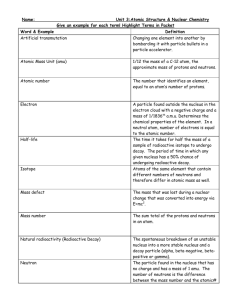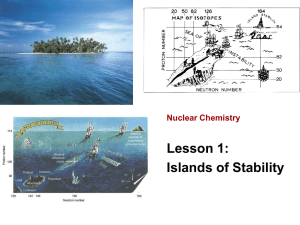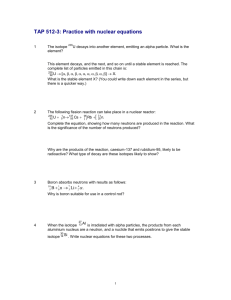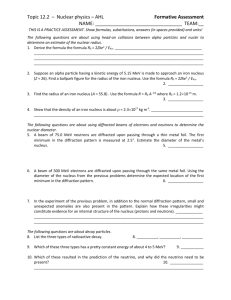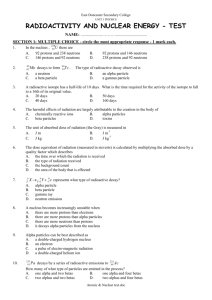Nuclear Physics Chapter Problems
advertisement
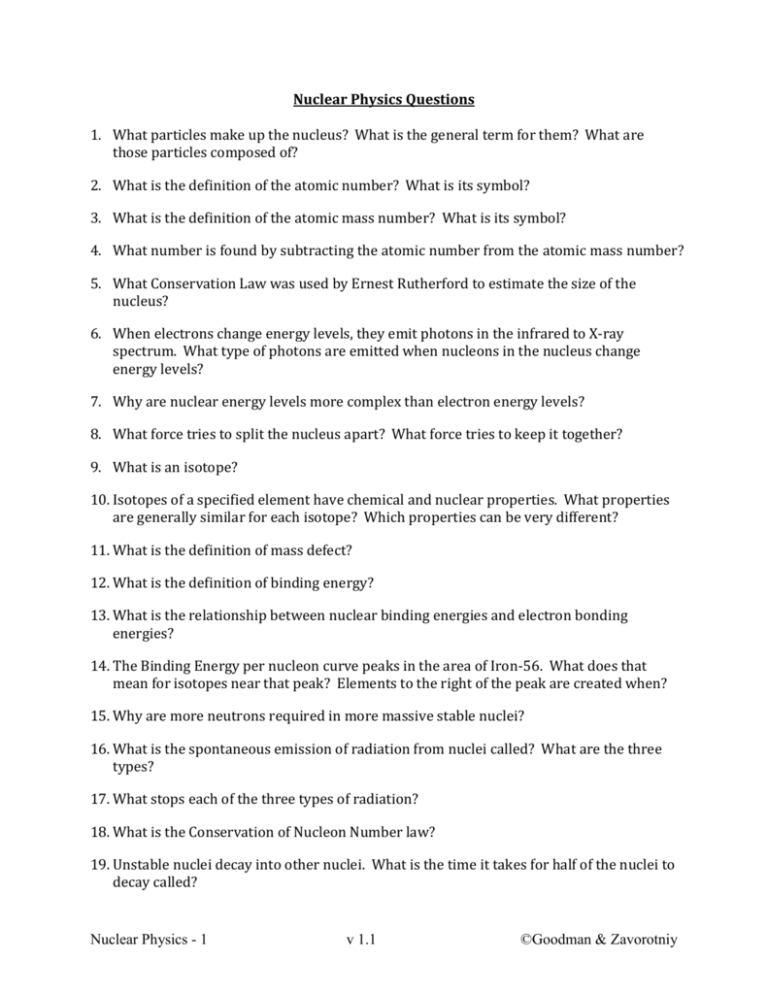
Nuclear Physics Questions 1. What particles make up the nucleus? What is the general term for them? What are those particles composed of? 2. What is the definition of the atomic number? What is its symbol? 3. What is the definition of the atomic mass number? What is its symbol? 4. What number is found by subtracting the atomic number from the atomic mass number? 5. What Conservation Law was used by Ernest Rutherford to estimate the size of the nucleus? 6. When electrons change energy levels, they emit photons in the infrared to X-ray spectrum. What type of photons are emitted when nucleons in the nucleus change energy levels? 7. Why are nuclear energy levels more complex than electron energy levels? 8. What force tries to split the nucleus apart? What force tries to keep it together? 9. What is an isotope? 10. Isotopes of a specified element have chemical and nuclear properties. What properties are generally similar for each isotope? Which properties can be very different? 11. What is the definition of mass defect? 12. What is the definition of binding energy? 13. What is the relationship between nuclear binding energies and electron bonding energies? 14. The Binding Energy per nucleon curve peaks in the area of Iron-56. What does that mean for isotopes near that peak? Elements to the right of the peak are created when? 15. Why are more neutrons required in more massive stable nuclei? 16. What is the spontaneous emission of radiation from nuclei called? What are the three types? 17. What stops each of the three types of radiation? 18. What is the Conservation of Nucleon Number law? 19. Unstable nuclei decay into other nuclei. What is the time it takes for half of the nuclei to decay called? Nuclear Physics - 1 v 1.1 ©Goodman & Zavorotniy 20. Define a nuclear reaction. What quantities are conserved during a nuclear reaction? 21. What is the definition of the reaction energy, or Q-value? 22. If Q is positive, what kind of reaction is it? Explain what happens do the energy in a positive Q reaction. 23. If Q is negative, what kind of reaction is it? Explain what happens do the energy in a negative Q reaction? 24. Why are neutrons so valuable in causing nuclear reactions to occur? 25. Describe what occurs in a nuclear fission reaction? 26. What is a chain reaction? 27. What is nuclear fusion and where does it occur? 28. What issue is preventing nuclear fusion from being used as a power source? Nuclear Physics - 2 v 1.1 ©Goodman & Zavorotniy Chapter Problems Nuclear Structure Class Work 1. 12 6𝐶 is an isotope of Carbon; what is the atomic number and the atomic mass number? 2. is an isotope of Copper; what is the atomic number and the atomic mass number? 3. 16 8𝑂 4. is an isotope of Uranium; how many neutrons, protons and electrons does it have? 63 29𝐶𝑢 is an isotope of Oxygen; how many neutrons, protons and electrons does it have? 235 92𝑈 5. What is the radius of the 218 88𝑅𝑎 nucleus? 6. What is the radius of the 137𝑁 nucleus? Homework 7. is an isotope of Chlorine; what is the atomic number and the atomic mass number? 8. 11 5𝐵 is an isotope of Boron; what is the atomic number and the atomic mass number? 9. 35 16𝑆 is an isotope of Sulfur; how many neutrons, protons and electrons does it have? 37 17𝐶𝑙 10. 208 82𝑃𝑏 is an isotope of Lead; how many neutrons, protons and electrons does it have? 11. What is the radius of the 210 81𝑇ℎ nucleus? 12. What is the radius of the 84𝐵𝑒 nucleus? Binding Energy and Mass Defect Neutron mass = 1.008665 u 1 1𝐻 mass = 1.007825 u Class Work 13. Calculate the mass defect and the binding energy of 42𝐻𝑒 (mass = 4.002602 u). 14. Calculate the mass defect and the binding energy of 73𝐿𝑖 (mass = 7.016003 u). 15. Calculate the mass defect and the binding energy of 56 26𝐹𝑒 (mass = 55.934940 u). Nuclear Physics - 3 v 1.1 ©Goodman & Zavorotniy Homework 16. Calculate the mass defect and the binding energy of 21𝐻 (mass = 2.014102 u). 17. Calculate the mass defect and the binding energy of 168𝑂 (mass = 15.994915 u). 93 18. Calculate the mass defect and the binding energy of 41 𝑁𝑏 (mass = 92.906377 u). Radioactivity Class Work − 19. 45 20𝐶𝑎 undergoes 𝛽 decay. Using a periodic table, find the resulting atom. 20. Fill in the missing component: 208 83𝐵𝑖 21. Fill in the missing component: 32 15𝑃 → 42𝐻𝑒+ ? → 32 16𝑆+ ? Homework + 22. 22 11𝑁𝑎 undergoes 𝛽 decay. Using a periodic table, find the resulting atom. 23. Fill in the missing component: 35 16𝑆 24. Fill in the missing component: 212 84𝑃𝑜 → 0 −1𝑒+ → ? 208 82𝑃𝑏+ ? Nuclear Half-life Class Work 25. An isotope of Bi has a half life of 2 minutes. How much of this isotope will be left after 8 minutes from a starting sample of 800 g? 26. Nitrogen-13 has a half life of 10 minutes. How long will it take for a sample of 500 g to be reduced to 62.5 g? 27. Carbon-11 has a half life of 20 minutes. How much of this isotope will be left after 60 minutes from a starting sample of 40 g? Homework 28. Fermium-257 has a half life of 3 days. How long will it take for a sample of 200 g to be reduced to 25 g? 29. Lead-210 has a half life of 22 years. How much of this isotope will be left after 110 years from a starting sample of 8.0 kg? 30. Radon-222 has a half life of 3.8 days. How much of this isotope will be left after 19 days from a starting sample of 160 g? Nuclear Physics - 4 v 1.1 ©Goodman & Zavorotniy Nuclear Reactions Class Work Fill in the missing component of the following reactions (see subset of Periodic Table at end of problem set): 1 4 31. 27 13𝐴𝑙 + 0𝑛 → 2𝐻𝑒 + ? 32. 126𝐶 + 11𝐻 → 33. ? + 11𝐻 → 13 6𝐶 + 22 11𝑁𝑎 34. 55 25𝑀𝑛+ ? → ? + 42𝐻𝑒 55 26𝐹𝑒 + 10𝑛 Calculate the mass defect (in amu) and reaction energy (in MeV) of the following reactions (missing components found above): 1 4 35. 27 13𝐴𝑙 + 0𝑛 → 2𝐻𝑒 + ? 36. 126𝐶 + 11𝐻 → 37. ? + 11𝐻 → 13 6𝐶 + 22 11𝑁𝑎 38. 55 25𝑀𝑛+ ? → ? + 42𝐻𝑒 55 26𝐹𝑒 + 10𝑛 Homework Fill in the missing component of the following reactions: 39. 168𝑂 + 42𝐻𝑒 → 𝛾+ ? 40. 21𝐻 + 31𝐻 → 42𝐻𝑒+ ? 41. 73𝐿𝑖 + 21𝐻 → ? + 10𝑛 1 42. 136𝐶 + 208 82𝑃𝑏 → ? +3 0𝑛 Calculate the mass defect (in amu) and reaction energy (in MeV) of the following reactions (missing components found above): 43. 168𝑂 + 42𝐻𝑒 → 𝛾+ ? 44. 21𝐻 + 31𝐻 → 42𝐻𝑒+ ? 45. 73𝐿𝑖 + 21𝐻 → ? + 10𝑛 1 46. 136𝐶 + 208 82𝑃𝑏 → ? +3 0𝑛 Nuclear Physics - 5 v 1.1 ©Goodman & Zavorotniy Nuclear Fission and Fusion Class Work Fill in the missing component of the following reactions and specify if they are fission or fusion: 145 1 1 47. 235 92𝑈 + 0𝑛 → 57𝐿𝑎 + ? +3 0𝑛 48. 136𝐶 + 42𝐻𝑒 → 16 8𝑂 + 1 49. 239 94𝑃𝑢 + 0𝑛 → ? 146 56𝐵𝑎 + ? +3 10𝑛 Homework Fill in the missing component of the following reactions and specify if they are fission or fusion: 148 1 1 50. 239 94𝑃𝑢 + 0𝑛 → 58𝐶𝑒 + ? +3 0𝑛 51. 147𝑁 + 42𝐻𝑒 → ? + 10𝑛 1 52. 235 92𝑈 + 0𝑛 → Nuclear Physics - 6 131 50𝑆𝑛+ ? +2 10𝑛 v 1.1 ©Goodman & Zavorotniy Isotope Reference Chart Atomic number 0 1 Element Symbol 2 3 4 5 (Neutron) Hydrogen Deuterium Tritium Helium Lithium Beryllium Carbon n H H or D H or T He Li Be C 9 8 10 11 Fluorine Oxygen Neon Sodium F O Ne Na 12 13 25 26 35 36 38 42 82 88 Magnesium Aluminum Manganese Iron Bromine Krypton Strontium Molybdenum Lead Radium Mg Al Mn Fe Br Kr Sr Mo Pb Ra Nuclear Physics - 7 Mass Atomic Number Mass (u) 1 1.008665 1 1.007825 2 2.014102 3 3.016049 4 4.002602 7 7.016003 8 8.005305 12 12.000000 13 13.003355 17 16 15.994915 20 19.992435 22 21.994434 24 23.990961 25 24.985837 27 26.981538 55 54.938048 55 54.938293 88 87.92407 89 88.91763 91 90.910203 103 102.91321 208 207.976652 218 218.007140 v 1.1 ©Goodman & Zavorotniy Chapter Questions 1. Neutrons and protons; nucleons; quarks. 2. The number of protons; Z. 3. The number of nucleons (protons plus neutrons); A. 4. The number of neutrons, N. 5. Conservation of Energy. 6. Gamma rays. 7. Instead of just electrons, there are neutrons and protons. There is a repulsive electromagnetic force and an attractive strong nuclear force. 8. Electromagnetic force; strong nuclear force. 9. Nuclei with the same number of protons but different numbers of neutrons. 10. Chemical; nuclear. 11. The difference between the total mass of the nucleons and the mass of the nucleus. 12. The amount of energy needed to break apart the nucleus into its constituent particles. It equals the mass defect times the speed of light squared. 13. Nuclear binding energies are on the order of 106 times the binding energies of electrons. 14. Those isotopes are very stable. Supernova explosions. 15. As the nucleus gets larger, the nucleons further from each other are not exposed to the strong nuclear force. More neutrons are required to overcome the Coulomb repulsive force. 16. Radioactivity; Alpha particle, Beta particle, Gamma ray. 17. Alpha particle – paper; Beta particle – sheet of aluminum; Gamma ray – meters of lead. 18. The number of nucleons that make up the reactants in a nuclear Nuclear Physics - 8 v 1.1 reaction equal the number of nucleons in the products. 19. Nuclear half life. 20. A nuclear reaction takes place when a nucleus collides with another nucleus and a change occurs in the nature of the nucleus; charge, nucleon number, massenergy, linear momentum, angular momentum. 21. The energy available from the difference in the mass of the reactants and the products. 22. Exothermic. More energy is released than is input into the reaction. 23. Endothermic. Less energy is released than is input into the reaction. 24. They are electrically neutral, so they can get very close to the nucleus. 25. A slow neutron penetrates a fissionable nucleus; the nucleus expands and the strong nuclear force is overcome by the repulsive Coulomb force and the nucleus splits into two similarly sized fragments and several neutrons. 26. When there are enough neutrons released from a fission reaction to strike other fissionable nuclei, and the cycle continues, releasing great amounts of energy. 27. The combining of two lighter nuclei to form a larger nucleus which results in the release of energy. 28. The difficulty of containing the extremely hot plasma that will support fusion. ©Goodman & Zavorotniy Chapter Problems 1. Z=6; A=12 2. Z=29; Z=63 3. 8 neutrons, 8 protons, 8 electrons. 4. 143 neutrons, 92 protons, 92 electrons. 5. 7.2x10-15 m 6. 2.8x10-15 m 7. Z=17; A=37 8. Z=5; A=11 9. 19 neutrons, 16 protons, 16 electrons. 10. 126 neutrons, 82 protons, 82 electrons. 11. 7.1x10-15 m 12. 2.4 x10-15 m 13. Mass defect: 0.030378u or 5.0444x10-29kg; Binding energy: 2.8297x101Mev or 4.5400x10-12J. 14. Mass defect: 0.042132u or 6.9962x10-29kg; Binding energy: 3.9246x101Mev or 6.2879x10-12J. 15. Mass defect: 0.528460u or 8.7751x10-28kg; Binding energy: 4.9226x102Mev or 7.8976x10-11J 16. Mass defect: 0.002388u or 3.9653x10-30kg; Binding energy: 2.2244Mev or 3.5688x10-13J 17. Mass defect: 0.137005u or 2.2750x10-28kg; Binding energy: 1.2762x102Mev or 2.0475x10-11J 18. Mass defect: 0.865028u or 1.4364x10-27kg; Binding energy: 8.0577x102Mev or 1.2927x10-10J 19. 45 21𝑆𝑐 20. 204 81𝑇𝑙 21. 0 −1𝑒 22. 22 10𝑁𝑒 23. 35 17𝐶𝑙 25. 50 g 26. 30 min 27. 5 g 28. 9 days 29. 0.25 kg 30. 5 g 31. 24 11𝑁𝑎 32. 01𝑒 33. 25 12𝑀𝑔 34. 11𝐻 35. -0.003360u; -3.130 MeV 36. 0.004470u; 4.164 MeV 37. -0.003374u; -3.143 MeV 38. -0.001085u; -1.011 MeV 39. 20 10𝑁𝑒 40. 10𝑛 41. 84𝐵𝑒 42. 218 88𝑅𝑎 43. 0.005082u; 4.734 MeV 44. 0.018884u; 1.759x101 MeV 45. 0.016135u; 1.503x101 MeV 46. -0.053128u; -4.949x101 MeV 47. 88 35𝐵𝑟 ; fission 48. 10𝑛; fusion 91 49. 38 𝑆𝑟; fission 89 50. 11 𝐾𝑟; fission 51. 179𝐹 ; fusion 52. 103 42𝑀𝑜 ; fission 24. 42𝐻𝑒 Nuclear Physics - 9 v 1.1 ©Goodman & Zavorotniy
